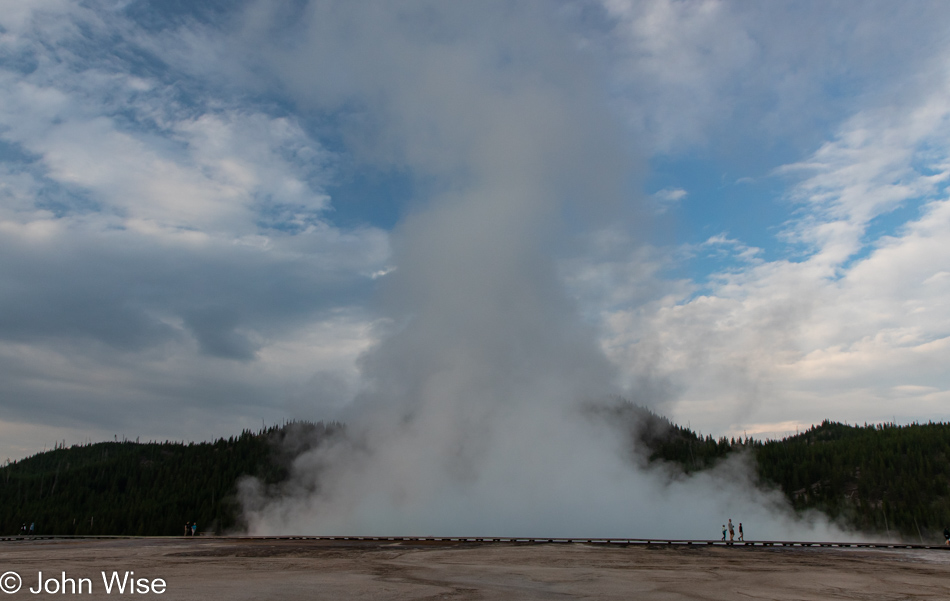
It’s right in front of you, the biggest of its kind on these shores, but you can’t see it as it hides below a veil of steam. We are at Midway Geyser Basin in Yellowstone National Park, and right there is the Grand Prismatic Spring. Some walk by disappointed that the thing they know from photos or TV is not can’t be seen by them today while I relish the idea that I’m once again in the proximity of greatness.

What would be needed to wake people to the fact that they are always near greatness? Because this rainbow-hued spring cannot be viewed in all of its vibrancy, people are grumbling while perceiving something was lost during their vacation. Nothing is common here; everything is out of the ordinary and unique, yet they fixate on seeing one or two things to define the value of where they’ve been. For some, seeing Old Faithful and bison will be enough to say they’ve seen Yellowstone, but that’s as shortsighted as going to Paris and briefly seeing the Mona Lisa and glancing at the Eifel Tower in order to tell everyone back home that they’ve been to the City of Light while ignoring the billions of other things that make Paris the city it is. While no one can see the entirety of a place in hours, we can be grateful for what we do have the opportunity to experience.
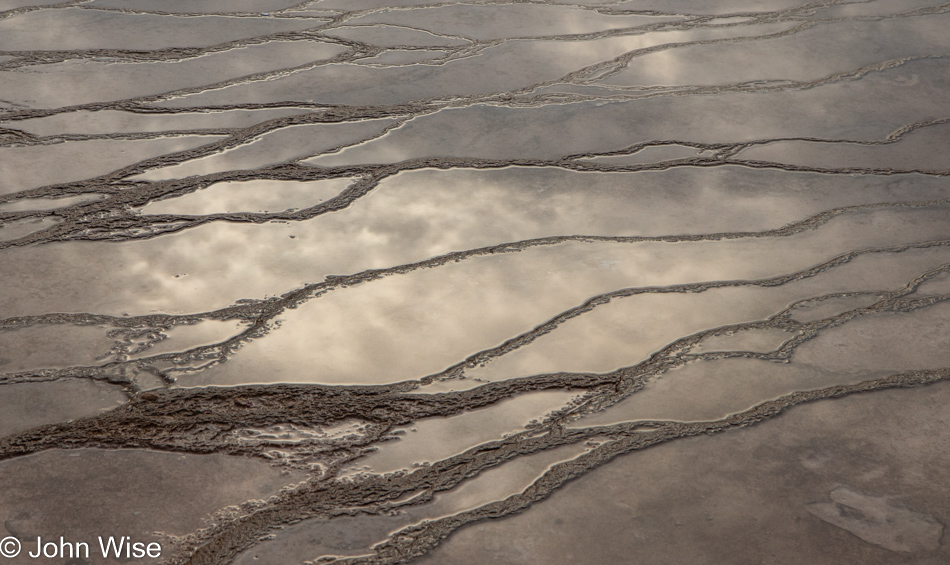
Looking at the earth below our feet, we can gaze into the heavens using the reflection of the sky above while the waters that flow from the Grand Prismatic Spring continue to build the travertine structures and create beds for the bacteria that live in these organic puzzle pieces. The tiniest bit of skill is required to extract words from the language to give meaning to where we are, but when we betray that potential by reducing our vocabulary to grumbling, we forget to pay homage to our humanity and good fortune. We do not only smile at the baby, we convey a multitude of cultural and emotional context that is sharing with the next generation what we find important. When we pass through nature and find disappointment that we didn’t see the bear or some other particular thing, we are breaking the contract of sharing our best traits with the next generation by teaching them to vocalize their disapproval for all those around them who might be enjoying the moment.
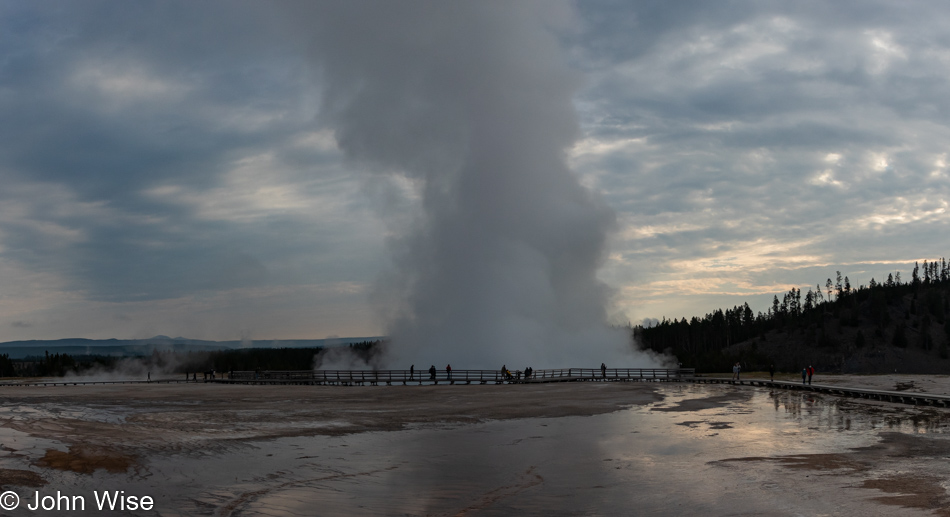
Behind me, while I was taking in the Grand Prismatic Spring, was the Excelsior Geyser, also shrouded in steam but with the gray sky and bits of sunlight peeking through. I looked at the reflections in that direction and couldn’t believe my luck at how many times I’ve stood in the park watching billowing clouds rise from hot springs that give us hints of things unseen below us.
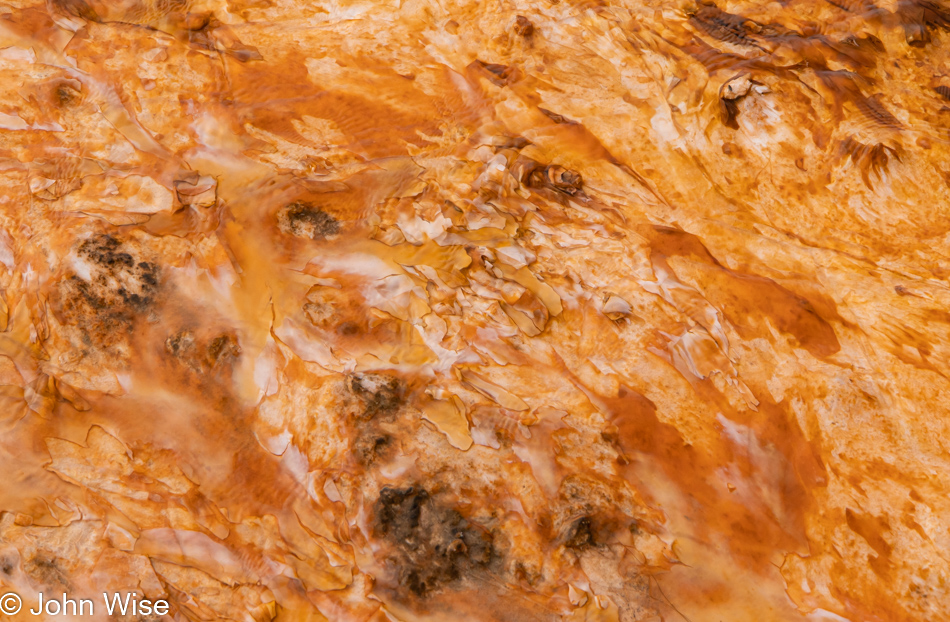
Words and emotions are the communicative hints of who we are within that are largely unseen by others. When we express ourselves with enthusiasm we are recognizing our good luck at how many times we’ve been in a situation worth sharing. Our essence of being human is locked in this exchange just as the waters of the geyser create the picture of the object you are looking for.
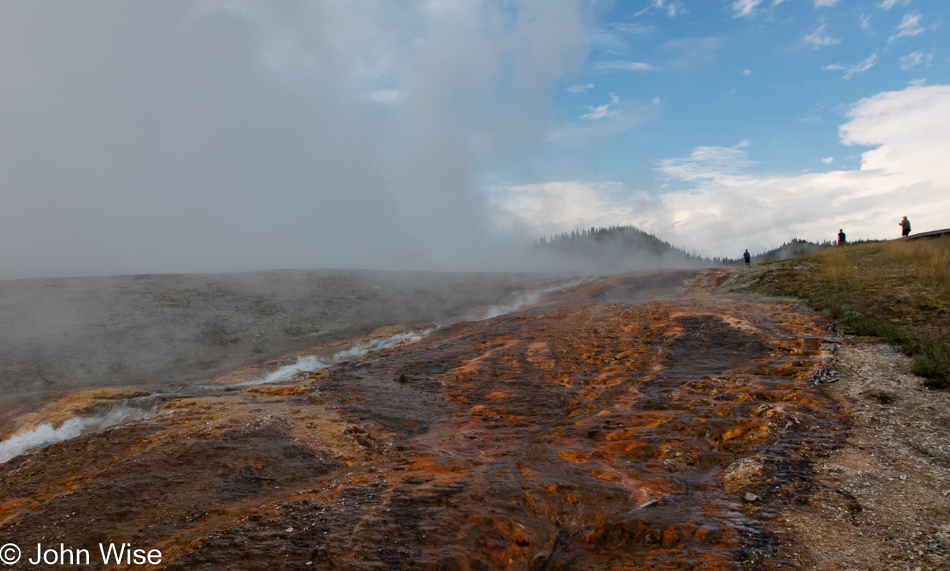
Far from the waters that flow from the hot spring, beauty is also to be found. In a similar sense, the words and emotions people share flow far away from them, offering impressions to artists and new generations who borrow from those precious moments to shape culture. To desire only the big picture is to throw away the largest mass of unrealized potential, and this is the condition of those who only desire to exemplify the most superficial nature of the self, the exterior. We inhabit a multitude of various planes of existence that create our cultural complexity, and yet, by displaying only our external selves, we fail to share the inner self, maybe because we are afraid of the person inside we don’t really know. In my view, it’s a tragedy that we fail at putting the deeper self on display while we invest so much energy and money visiting the gym, buying trendy clothes, the right accouterments, tattoos, our cars, and homes that demonstrate the external self. We should aim for the same symbiotic relationship of elements we witness in the complex beauty we find in nature. When someone is more aligned with that symbiotic balanced personhood, we are better prepared to find magnificence in the little things.
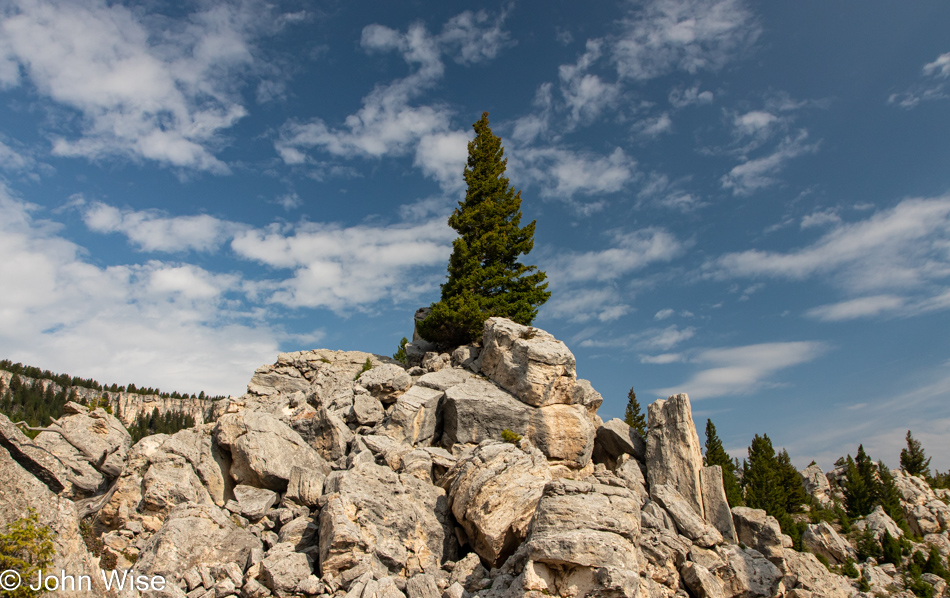
Standing on our own atop a monument of what lies below the surface takes daring, as in our culture, we have no real room for individuality. Like here in Yellowstone, we don’t care about the hydrological function below the surface; we only desire to see the herd of animals, the forest, or the geyser as it’s geysering.
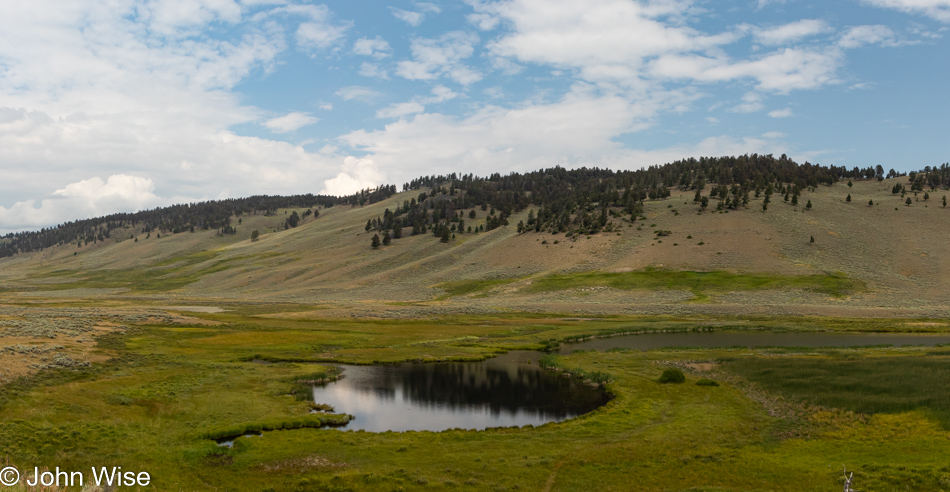
Excited to get to Grand Prismatic before the crowds, we waited for breakfast until we reached the perfect place for it. That ended up being after we turned east, away from Mammoth Hot Springs, on our way to the Lamar Valley at Blacktail Pond Overlook. I should finally note that we are traveling with much of our own food to cut down on expenses, hence why our first meal of the day was roadside.
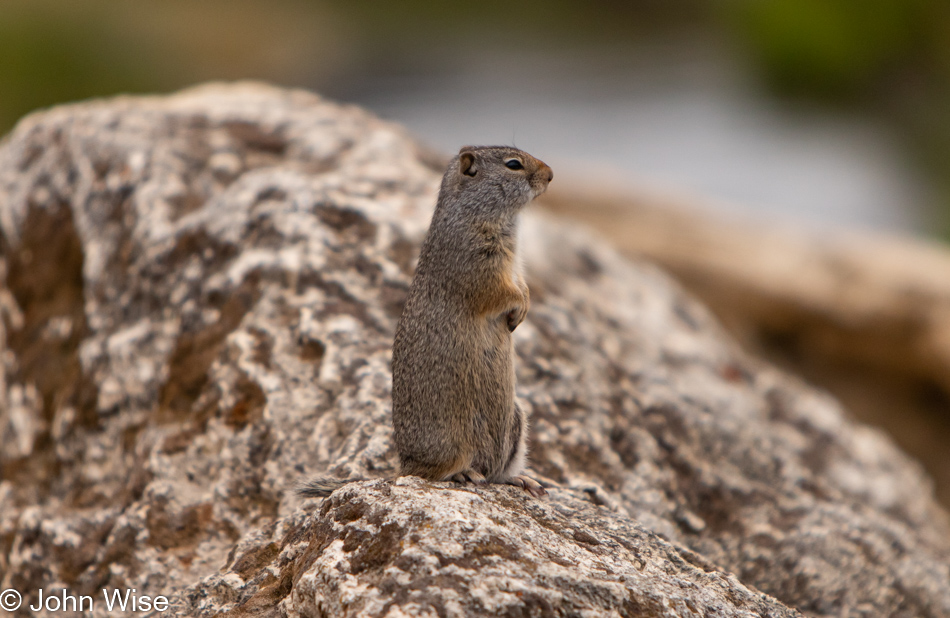
I have to give my daughter credit as, like this ground squirrel, she takes an intense interest in observing stuff and trying to find her own angle as she snaps away, taking photos that will join her book of memories. The entire drive from Phoenix to this corner of Wyoming, she’s been talking about seeing animals along the way; this is the reminder for her that she not only saw ground squirrels but even had one rush up to her and try to poop on her shoe.
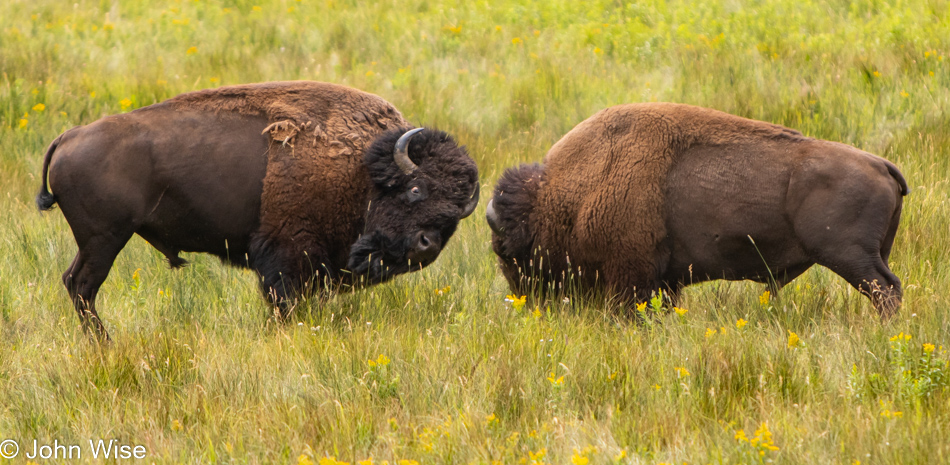
It’s rutting season for the bison, and the males are emitting some impressive guttural sounds. If their size doesn’t frighten you, these deep grunts certainly will.
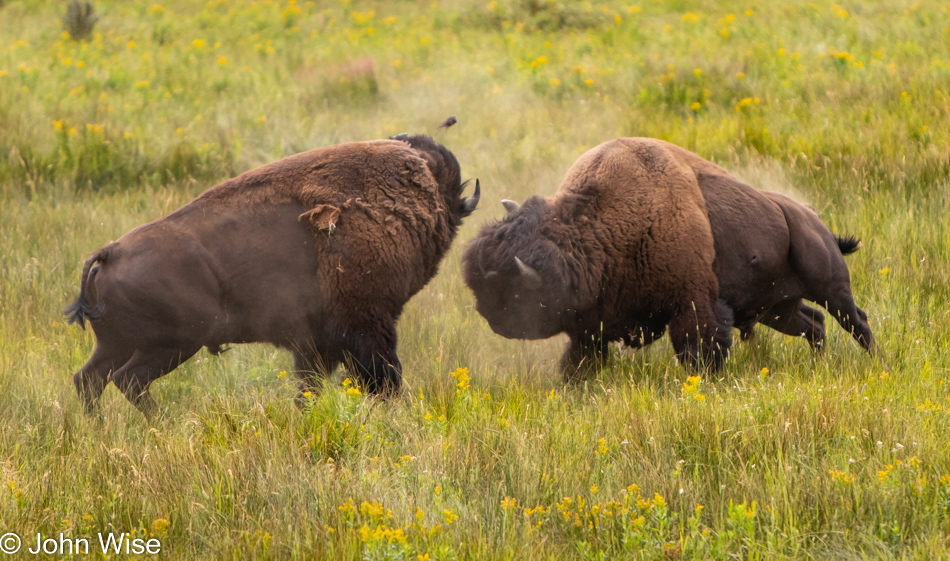
As they compete for dominance among one another, they pair off and let the fur fly as we onlookers marvel at the primal force and musculature on display here in the park. Jessica and I were able to hang out at a safe distance and watch the fury the bison were directing at rival males to land prime mating opportunities if they could prove they were at the apex of this hierarchy.
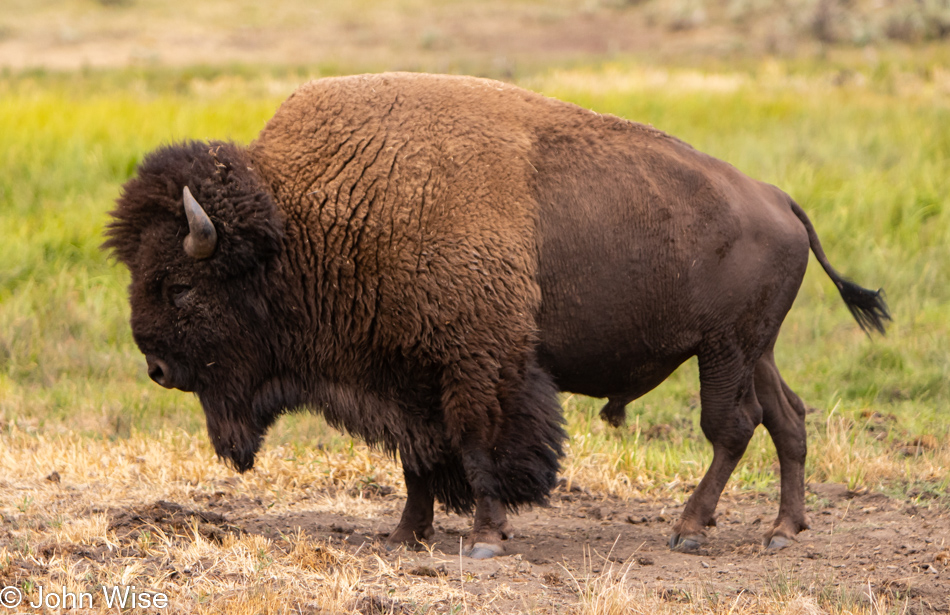
These incredibly beautiful animals are but a few of the 360,000 that exist in the North American herd today. Prior to the arrival of our European ancestors, it is estimated that 30-60 million of them existed. At the low point, only about 1,000 of them were alive as they verged on extinction. If farmers on the borders of Yellowstone had their way, this herd would be destroyed as they risk bringing disease to the nearby cattle populations. A disease that ironically was brought in by non-indigenous cattle in the first place. By the way, those 360,000 bison are nothing when you think that right here in the United States, we slaughter 46 million cows, 121 million pigs, and 9 billion chickens per year, and it’s the existence of 360,000 bison that irks the cattle industry.
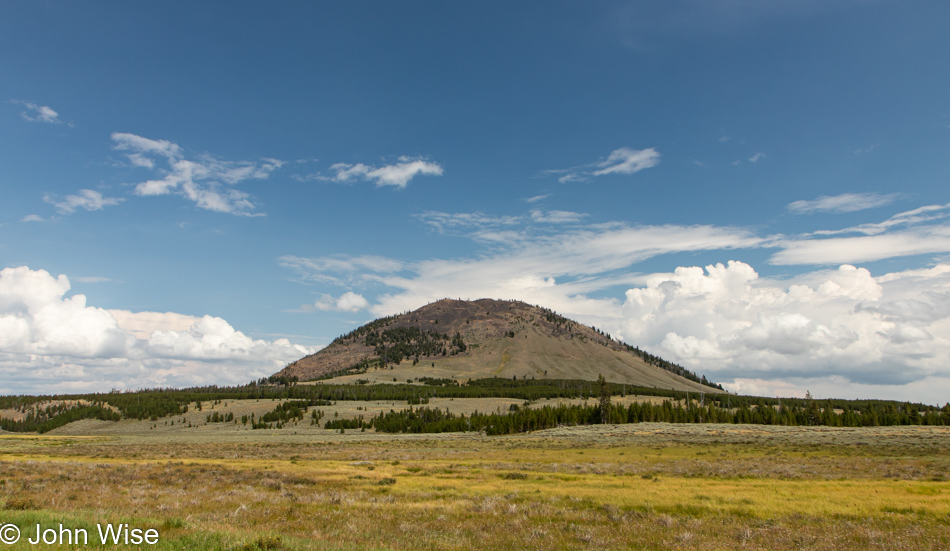
Okay, I’ll get off the mountain and come back down to being a tourist. Leaving Lamar Valley, we couldn’t take the road that passes Mt. Washburn (this is not that mountain) as that road is closed for construction. So we backtracked through Mammoth, past Norris Geyser Basin, where we turned left towards the lake again in hopes of seeing more elk.
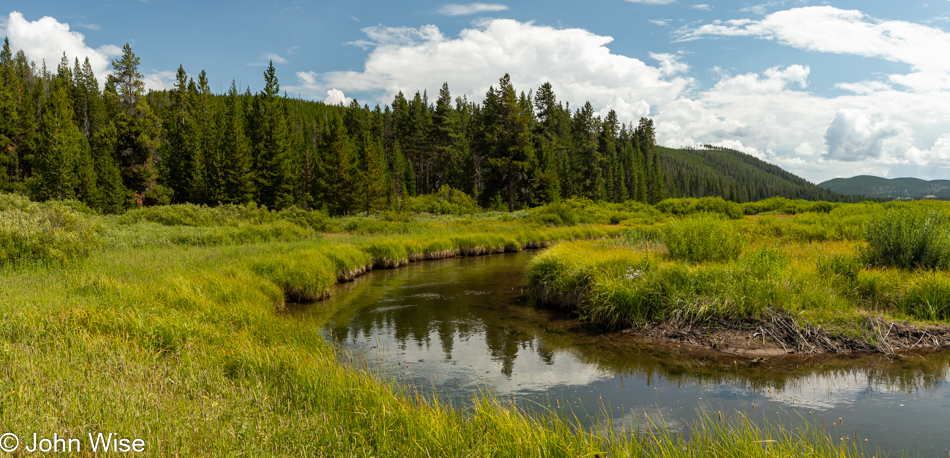
Okay, so this isn’t wildlife, but if you think about it for a moment, this is wildlife.
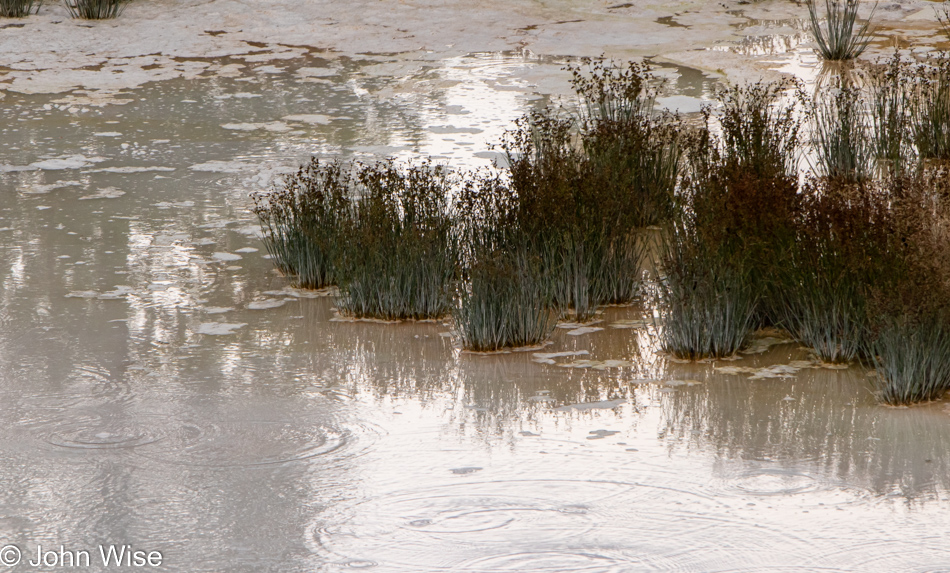
Over the course of our drive to West Thumb Geyser Basin, we spotted a few elk, but with periodic rain and dark skies, I wasn’t able to capture a half-decent image, but that’s okay, by the time we reached this corner of the lake we had a respite in the foul weather.
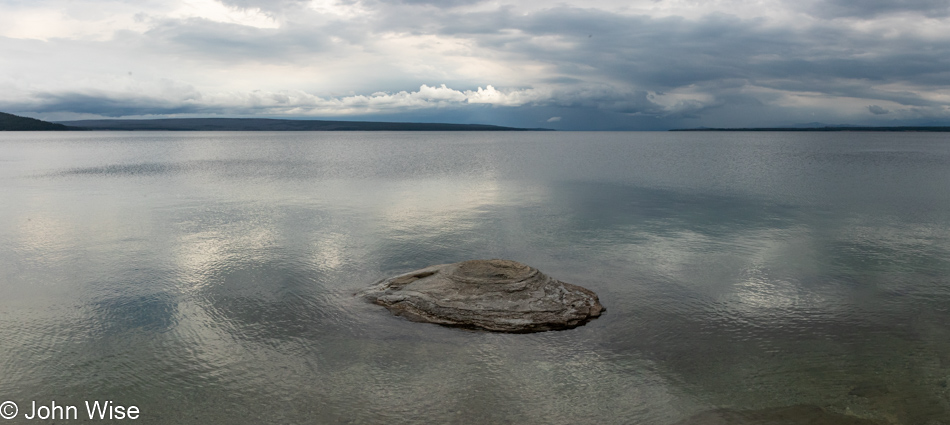
Here at the Fishing Cone, it was common practice 120 years ago to stand on the cone and fish for trout. Once caught, the fish was dunked into the hot waters of the geyser and cooked before incredulous visitors. Back then, it was possible to see this geyser erupt to heights of 40 feet over the lake.

Back in 2003, the boardwalk led right up against this hot spring. I can only imagine it was moved closer to the lake to help stop people throwing stuff into the pool. While we are lucky to have been able to walk the original trail, I understand that we humans are not trustworthy to follow the rules and act respectfully. If you’d like to see that old boardwalk and what this pool looks like on a sunny day, click here and scroll down 24 photos.
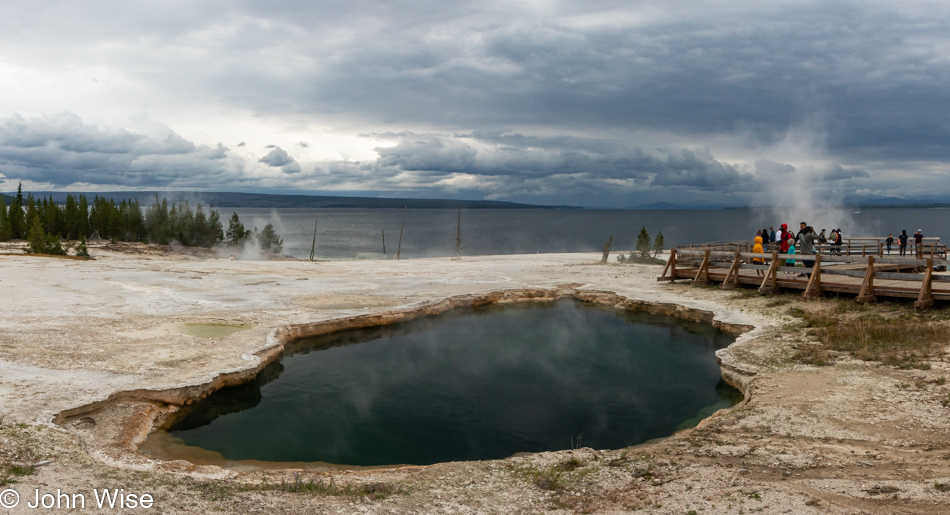
Here we are at the edge of controlled and wild nature. In one corner, we have the National Park’s attempt at controlling people who oftentimes are being introduced to a vast, uncontrollable side of America, and in the other corner the untameable and unpredictable face of a caldera. Nature cannot bow to our will, though we do have the ability to harm it. In the end, it has a greater ability to inflict destruction upon us in profoundly unsettling ways. We are the ones who, with knowledge and the ability to control our actions, are supposed to respect nature and support how we can symbiotically live within it as it sustains us and all other life.

This dry, hot spring that might have also been a geyser is a dusty bowl here on our visit. Is it only dry due to the time of year, was it clogged with debris people threw into it, or is something ominous at work where the hydrology of the park is cooking up even bigger changes? We are not afforded the luxury of knowing the intention of such large complex systems below the surface of the earth, so why do we think we can control even larger and more complex systems such as oceans and the atmosphere of our planet? I think indigenous people are correct in saying that modern man does not pay enough respect to the land we live on or the skies we live under.
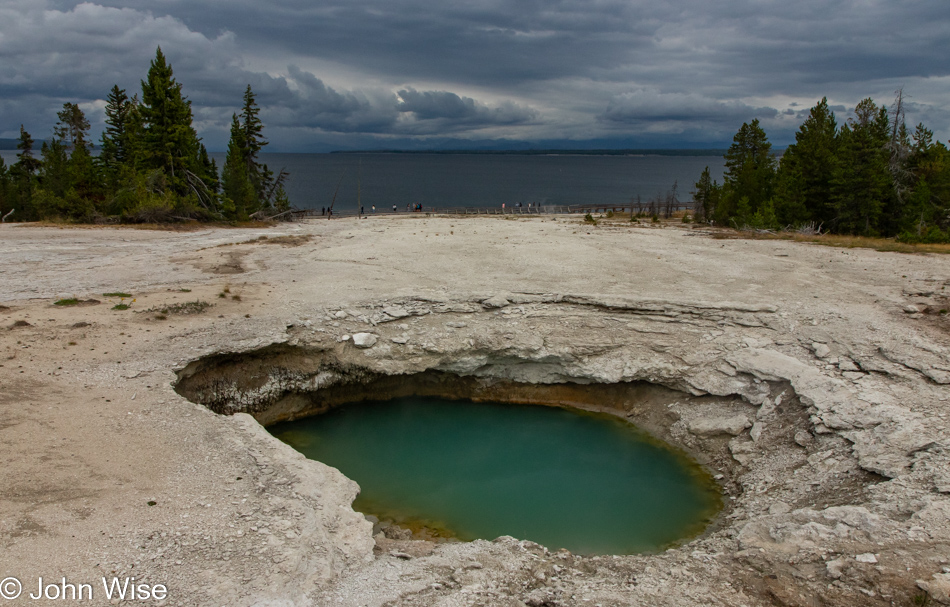
Forboding sky, meet convulsive earth, with these little naive people standing between you who believe they reign tall in the hierarchy of this spectacular evolving creation. I dream of the day they stand with respect before nature and harness their knowledge to instill values in their kind that are able to invest in places such as this in the same way they do their cars, homes, and cities. Fortunately for humans, there are no destructive hordes of creatures harvesting or burning their cities, and there are no other animals or organisms on earth that intentionally poison their drinking water or work so vigilantly as they themselves do to soil their environment. In that respect, humans might be one of nature’s biggest mistakes.

Well, here we are back at Midway Geyser Basin for a late-day visit to Grand Prismatic Spring to see how conditions changed between morning and now.

Everything checks out for being in its place. Beauty still rules the view. Best of all though, thanks to the overcast skies, the parking lot, earlier quite overloaded with dozens of cars waiting to get in, was half empty, meaning we were here mostly alone. Just us here with some hot springs, distant trees, threatening storm clouds, the warm and glorious bacteria cheering our return, and some unfathomable amount of air and earth. Yep, just us.
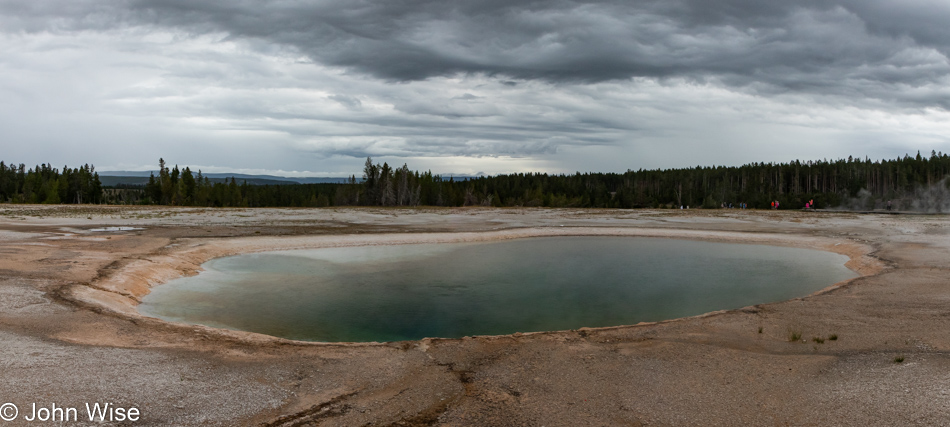
Hey John, is this really one of your best examples of photographic magic? Well, that’s purely subjective, isn’t it? What I can assure you of is that it’s a snapshot of a place and a moment that I experienced with my daughter here on August 2nd, 2021.
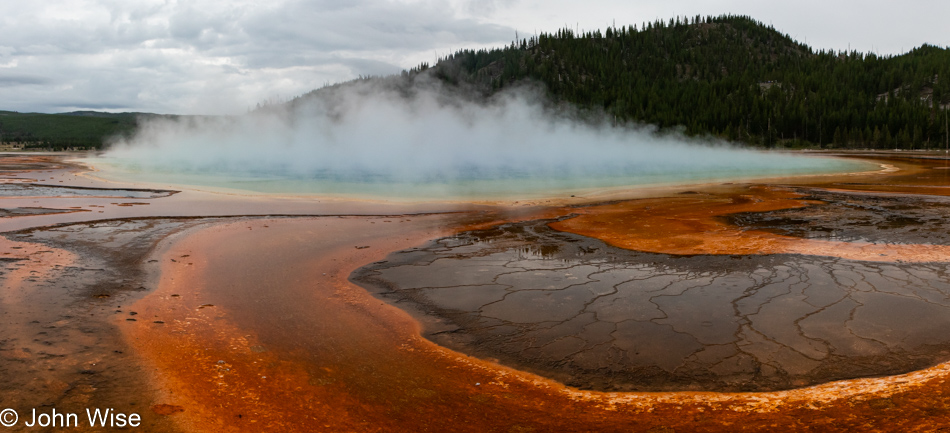
Yep, that’s lava flowing out of the water, or maybe it’s a trillion parties of bacteria in their lit cities, as seen from this satellite view. Oops, I was wrong; this is the work of Banksy, who threw down some damn realistic-looking graffiti turning this plain old hot spring into a multi-billion dollar artwork.